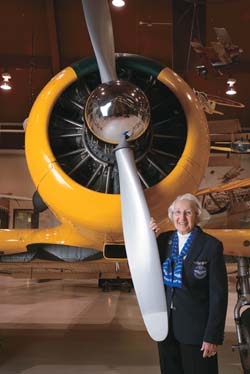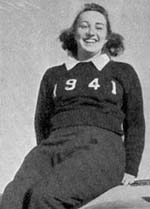 |
 |
| current issue |  |
past issues |  |
send a letter/news |  |
address update |  |
advertise |  |
about us |  |
alumni home |
Alumni Profiles
Taking FlightWASP pilot Jeanette Gagnon Goodrum '41 helped break barriers
By Karen Tongue Hammond '64
 REUNITED: Pilot Jeanette Gagnon Goodrum '41 with an AT-6D at the Evergreen Aviation Museum in McMinnville, Ore.
REUNITED: Pilot Jeanette Gagnon Goodrum '41 with an AT-6D at the Evergreen Aviation Museum in McMinnville, Ore.
|
Growing up in Massachusetts, Jeanette Gagnon Goodrum '41 remembers the excitement she and her friends felt whenever a plane flew over. "We'd all race outside to see it," she says. Little did she know that as a college student, she would be in the pilot's seat.
In 1940, a Civilian Pilot Training Program was implemented at UNH to prepare for war. Goodrum was UNH's only female trainee. She passed the flight examination in January 1941 in a Taylorcraft plane with five instruments, no radio and skis instead of tires to cope with New Hampshire's snowy terrain.
"I was so excited that I had this opportunity," says Goodrum, now 87 and living in Lake Oswego, Ore. "We trained on a little field in Portsmouth that was not much more than grass." The men in the program treated her as an equal, she says. "I think they thought it was exciting that a woman was going to fly." She recalls that her biggest hurdle was UNH's strict regulations prohibiting women from entering fraternities and men's dorms, a problem when she needed to study with her classmates. "I talked to the housemothers, who let me in long enough to study."

|
Goodrum was not called into service while in college, and after graduation taught school for a year before becoming assistant dean at American University in Washington, D.C. Then came an opportunity that would once again send her soaring. In 1943, hearing that the Women Air Force Service Pilots were looking for licensed female pilots, Goodrum applied. Of 25,000 applicants, only 1,074 made it. Goodrum's duties in Texas included production line maintenance and aircraft testing, often in adverse weather conditions. Despite the obvious danger, "I have never done anything more exciting or rewarding," she says.
Goodrum flew AT-6, AT-9 and AT-11 planes, among others. "I was thrilled to fly the AT-6," she says. "It had landing gear that went up and 13 instruments." Thirty-eight women died while carrying out their duties, "mostly during storms," says Goodrum. Because the women did not have official military status, the families of those who died had to bring them home at their own expense, and the women received no military honors or benefits.
The WASPs disbanded in December 1944 and Goodrum married a career Air Force pilot and raised their family. It was not until 1977 that the WASPs finally achieved full military status. In 1984, all WASPs, or their surviving family members, were awarded the Victory Medal. Looking back, Goodrum says she was too focused on the war effort to think about the long-term effect she and the other WASPs were having. "Later we realized that we had broken the barrier for women pilots and mechanics." At the U.S. Air Force Academy, a statue depicts a WASP in her flight uniform and the WASP's motto: "We live in the wind and sand and our eyes are on the stars." More than 60 years later, Goodrum still remembers the thrill of reaching for those stars.
Easy to print version blog comments powered by Disqus
